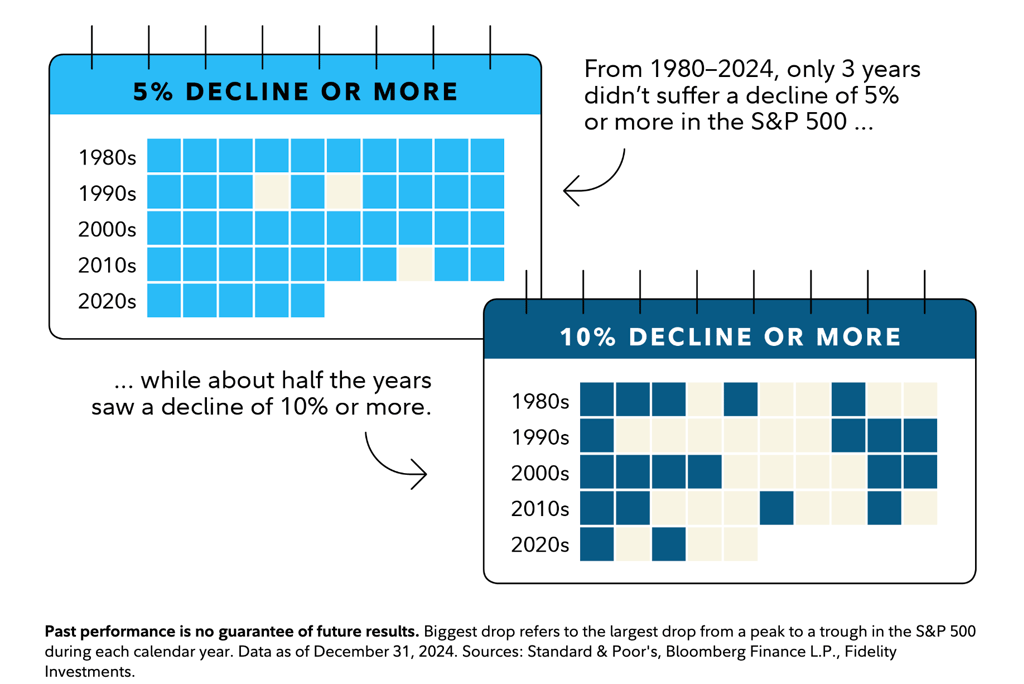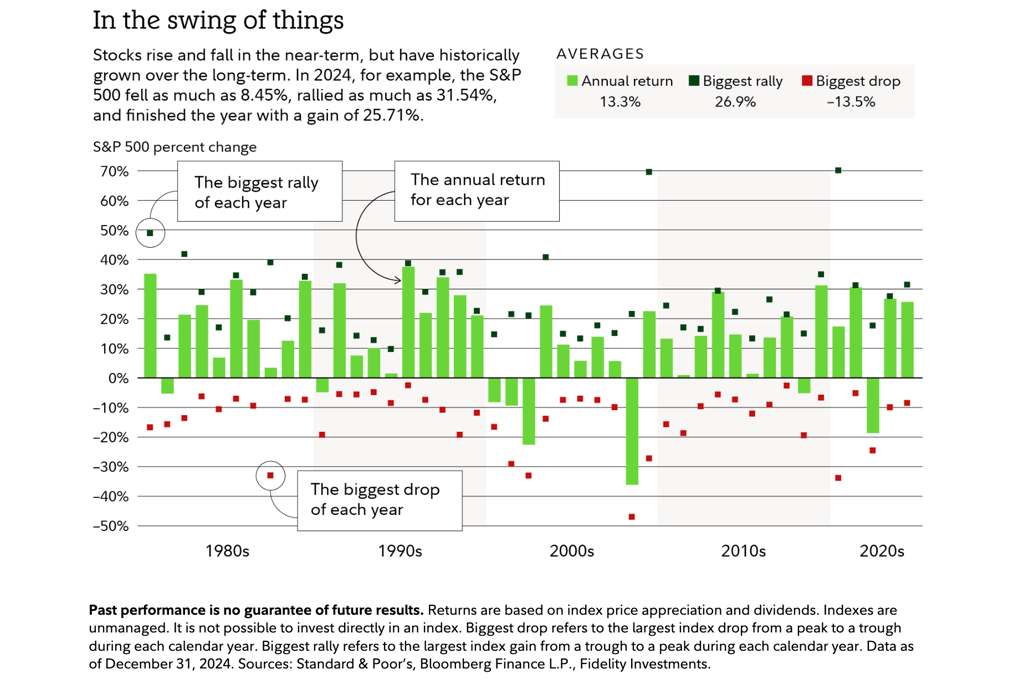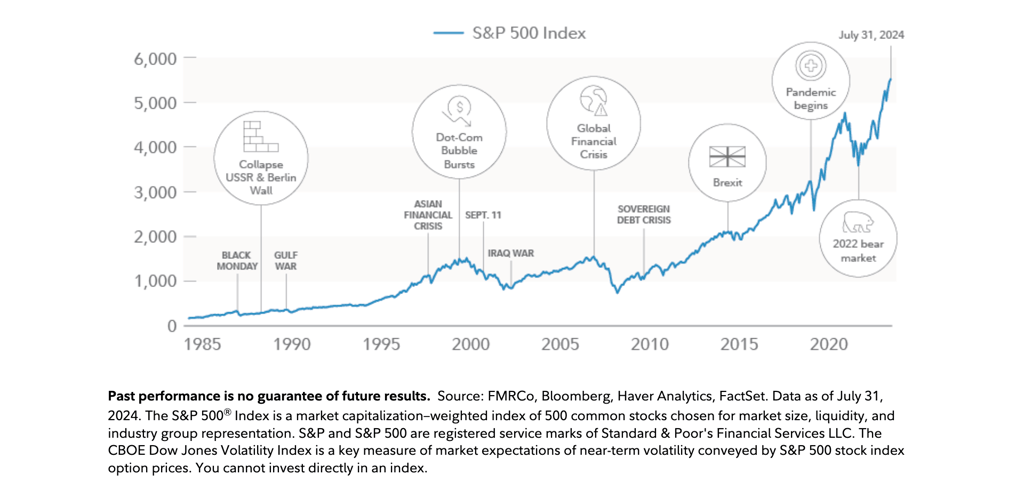Key Insights
• Market corrections are a routine occurrence in the world of investing.
• Though it’s easy to worry during a downturn, history shows the U.S. stock market and economy have consistently bounced back from even the toughest declines.
• With market dips being unavoidable, having a solid investment strategy you can stick to through thick and thin is essential.
After hitting record highs in February, the S&P 500® Index—a benchmark of large U.S. companies—has dropped over 10%. While there’s no formal definition, a 10% decline from a peak is widely viewed as a market correction.
This recent pullback appears tied to growing unease about global economic growth. Consumer confidence has weakened, first-quarter growth estimates have softened, and U.S. companies have announced more layoffs in recent weeks.
With a correction underway, let’s take a closer look at what these moments have historically meant—and what they could mean for you.
Are Corrections Unusual?
Not at all. While they can rattle nerves, corrections are a standard part of the investing landscape.
Since 1980, the S&P 500 has seen a drop of 5% or more in 93% of years and a decline of 10% or more in nearly half of them.
Yet, despite these frequent dips, the S&P 500 has averaged a 13.3% annual return over the same period. That’s a reminder: short-term stumbles don’t erase long-term growth.
How Long Will This Last?
No one can predict exactly when stocks will rebound or how deep this correction might go. Economic forces and unexpected events make it impossible to know for sure.
But history offers some comfort—market recoveries from corrections have often been swift. Take a look at this chart: red dots mark the biggest annual drops in the S&P 500 since 1980, while green bars show the year-end returns. Even with significant declines, the market has frequently ended the year in positive territory.
On average, the S&P 500 has seen a 14% drop within a year since 1980,” notes John Khoury of Savvy. “But it’s still managed to finish most years with gains averaging 13%, including dividends. A 10% or 15% dip isn’t out of the ordinary—and it doesn’t mean the sky is falling.”
Is This Time Different?
It’s natural to wonder if this correction signals something bigger. During uncertain times, fear can take hold. But let’s step back: the U.S. economy and markets have weathered everything from recessions to pandemics and even a depression—only to emerge stronger each time.
A long-term view helps put things in perspective. Major drops—like Black Monday in 1987 or the COVID-19 crash in 2020—felt seismic in the moment. Yet, on a chart of monthly S&P 500 returns, they’re just blips in a broader upward climb.
"Markets can overreact to news in the short term, but over time, stock prices tend to follow corporate earnings." Says Khoury. "Profits grew 14% in Q4 last year, and analysts expect double-digit growth in 2025. That’s a solid foundation for optimism.”
Why Savvy Wealth Stands Out
"At Savvy, we believe wealth management isn’t just about numbers—it’s about understanding your story. Our team combines cutting-edge insights with a personal touch to guide you through market ups and downs. Whether it’s crafting a tailored plan or adjusting as life evolves, we’re here to keep you on track.”
What Should You Do?
Watching stocks fall can test your resolve, but staying calm is often the smartest move. Selling in a panic locks in losses and risks missing the rebound. Here’s how to approach it, depending on your situation:
For Long-Term Investors: Stay the Course
If you’re saving for a goal years away—like retirement—now isn’t the time to rethink your risk tolerance. That’s a decision to make when you’re calm and focused on your big-picture plan. Don’t have a plan? Let’s build one. Have one? Check if your investments still align with your goals, timeline, and comfort with risk. One way to stay steady: diversification. At Savvy Wealth, we use dynamic allocation strategies to balance growth and stability—customized to you. It’s not about avoiding every dip; it’s about being prepared for them. If your mix is off, a rebalance might be in order.
For Retirees: Protect Your Income
If you’re retired and drawing income from your portfolio, a dip can feel more personal. A well-designed income plan should handle market swings without forcing changes. If you’re unsure about yours, let’s talk—our team at Savvy Wealth can help refine your strategy.
The Bottom Line
We can’t say if this pullback will be brief or the start of something bigger. But history tells us markets recover, and a strong investment plan is built to handle turbulence. At Savvy Wealth, we’re here to help you navigate these moments with confidence—because corrections aren’t the end of the story, just a chapter in the journey.
Investing involves risk, including risk of loss.
Past performance and dividend rates are historical and do not guarantee future results.
Diversification and asset allocation do not ensure a profit or guarantee against loss.
Stock markets are volatile and can fluctuate significantly in response to company, industry, political, regulatory, market, or economic developments. Investing in stock involves risks, including the loss of principal.








